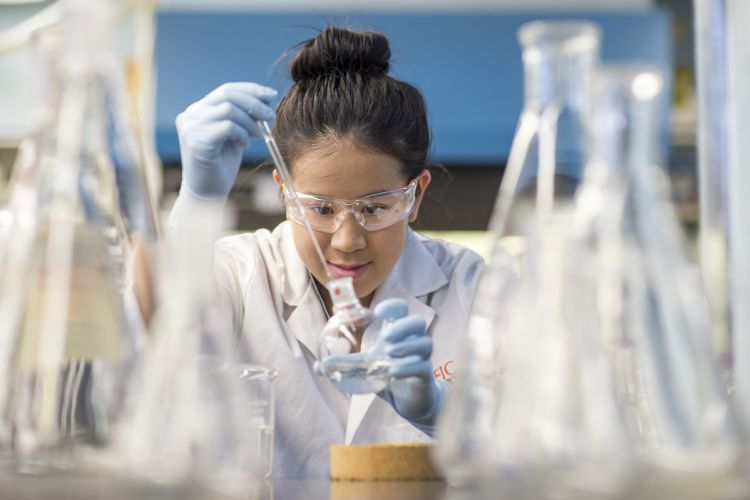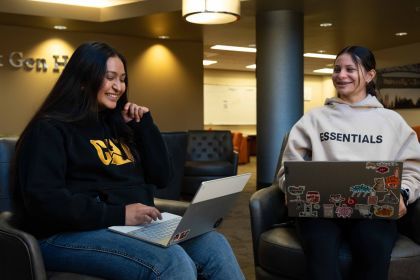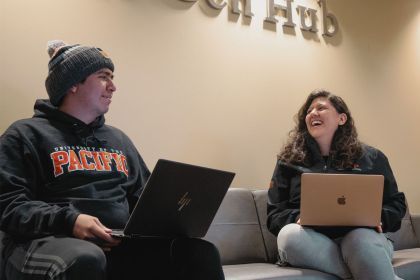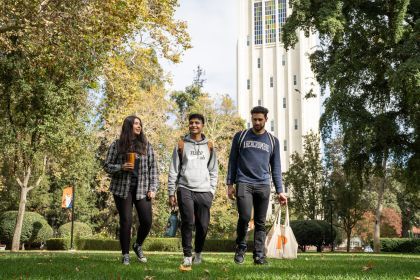Breadcrumb
Pacific celebrates student research at Undergraduate Research and Creativity Conference

Students showcased their research during Pacific's 21st annual Undergraduate Research and Creativity Conference
The range of topics was as expansive as the talent as students presented how 3D models could help detect ovarian cancer, how technology can help predict the stock market and the effects of income inequality in Stockton at Pacific's 21st annual Undergraduate Research and Creativity Conference.
More than 30 Pacific students shared oral and poster presentations of research they had conducted this year, adapting to experimentation in a virtual setting.
"Pacific's Undergraduate Research and Creativity Conference provides students the opportunity to pursue their own unique research interests, which helps them explore career directions and have the kind of hands-on experiences that enhance their resumes," said Lydia Fox, director of undergraduate research. "I am particularly proud of the work students have done this year remotely to overcome the challenges of conducting their research outside of their traditional lab settings."
Highlights of this year’s virtual presentations included:
Using 3D Co-Culture Models to Study Ovarian Cancer Metastasis and Pathophysiology
Jennifer Moreno '23, bioengineering major
Faculty mentor: Maria Gencoglu, assistant professor of bioengineering
Despite the advances in treatment over recent decades, cancer remains a leading cause of death worldwide. Ovarian cancer is the second most common gynecologic malignancy, but takes the greatest number of lives compared to any other cancer infiltrating the reproductive system.
"Most patients are diagnosed at late stages due to the rapid metastasis of ovarian cancer tumors and the lack of understanding regarding the complete pathophysiology of ovarian cancer," said Moreno. "Current medical care focuses on chemotherapy treatments, which take an aggressive toll on patients and have a low rate of cure with 70% of patients experiencing a relapse."
Three-dimensional co-culture models have become more prevalent over two-dimensional conditions where cells are grown on rigid materials such as polystyrene and glass. Cells grown in two-dimensional conditions do not fully reflect the essential physiology of real tissues as shown with three-dimensional co-culture models.
"These models can provide insight into biological responses of tumors, including drug resistance, cell-to-cell interactions, and metastasis," said Moreno. "Using a 3D co-culture model enables us to study the mechanism through which ovarian cancer metastasizes, as well as potentially helping to identify certain biomarkers associated with ovarian cancer."
Moreno hopes her research will help facilitate early detection of ovarian cancer, as well as increase treatment possibilities for patients who may not have favorable reactions to current treatments.
Machine Learning in Finance: Using Neural Networks to Predict Stock Returns
Arthur Jones '21, business administration major
Faculty mentor: Vusal Eminli, associate professor of finance
Stock return predictability is one of the most important concerns for investors. Throughout the years there have been many attempts to predict stock returns using machine learning, which has used historical time series data on share prices to make these predictions.
"Those attempts created networks which only work on one firm's data, and could be applied generally," explained Jones. "This study used a neural network, a computer system modeled on the human brain and nervous system, to predict stock returns based on financial and economic data."
Machine learning in finance is a supervised learning approach that uses multiple factors to explain stock returns as input values and future stock returns as output values. Jones' method tried to predict whether a given stock would beat the S&P 500 index over a future time period. During the study, his method reached a prediction accuracy of 64.5%.
"This is really exciting, a method which makes consistently accurate predictions helps to identify additional factors that determine a firm’s value beyond what is generally accepted in the literature," Jones said.
Jones hopes that his results indicate that his study shows promise as a skillful machine learning method and could be used to enhance the prediction accuracy of stock returns in the future.
Educational Implications of Income Inequality in Stockton
Jessica Alva '21, applied mathematics and economics major
Faculty mentor: Sharmila King, chair and professor of economics
Income inequality is a growing issue in the United States as studies have shown that many educational factors are related to future income and contribute to this income inequality gap.
According to the Education Equality Index, the first national comparative measure of the achievement gap at the school, city and state levels, Stockton ranked 85th nationally for achievement gaps in education among the 100 largest cities in the nation by census population.
"Despite being just over an hour away from the Bay Area, Stockton has a substantially lower high school graduation rate, lower college graduate rate and higher poverty rate than the nation as a whole," said Alva. "Without enacting effective educational measures, Stockton risks falling further behind."
Among Stockton residents, 77% have graduated from high school, 18% are college graduates and 15% have an income below the poverty level, according to the United States Census Bureau. In comparison, in the Bay Area 87% of residents have graduated from high school, 43% are college graduates and 10% have an income below the poverty level.
"Without enacting effective educational measures, Stockton risks falling further behind in these regards," said Alva.
Alva is working to identify the educational subject areas most adversely affected by income inequality and suggest where educational resources should be utilized to most effectively combat income inequality through its effects on education in Stockton.





